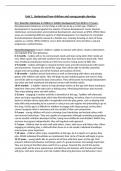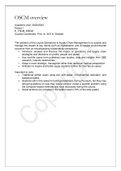Unit 1, Understand how children and young people develop
Q1.1 Describe milestones in children’s holistic development from birth to 19 years.
Developmental milestones are the things a child can do by a certain age. Children’s
development is measured against five aspects of human development: social, physical,
intellectual, communication and emotional development, also known as SPICE. Whilst these
areas are considering different aspects of child development, it is important to remember
that development should be viewed in a holistic way, meaning focusing on each of these
aspects as a whole. Whilst children vary in their development, they do follow a natural
progression, outlined below.
Social Development involves children’s ability to interact with others, relate to themselves
and regulate their own behaviour.
0-3 months – babies will cry to communicate needs and stop crying when their needs are
met. When upset, they will seek comfort from those they have formed a bond with. Their
own emotional and physical needs are their key concern, being aware of little else.
3-9 months – babies will begin to respond to their name and will communicate with noises
and movements. Towards the end of this stage, they will be able to identify unfamiliar
people and surroundings and will be hesitant and cautious of them.
9-18 months – toddlers amuse themselves as well as interacting with others and playing
games with children and adults. They will begin to play imitative games and want to help
and will be able to respond to basic instructions. They will become increasingly independent
but enjoy and seek emotional and physical contact with familiar adults.
18-24 months – a toddler’s desire to help develops further at this age with them wanting to
help their close ones with tasks such as tidying away. Mimicking behaviours also increase.
They enjoy playing alone and with others.
2-3 years – engaging in routine activities is beneficial at this age. Toddlers will often play
alone and enjoy repeating tasks which they find stimulating. As before, there is an increased
desire to imitate others especially in imaginative and role-play games, such as playing with
baby dolls and pretending to be a parent or using a toy cash register and pretending to go to
the shop. At this age it is difficult for toddlers to engage with larger groups as they often
cannot recognise other’s autonomy and see outside of their own perspective.
3-5 years – young children will start to develop close friendships and exclude others with
non-inclusive behaviours. They are capable of cooperation although reminding and guidance
can be needed. Imitation develops further, being more deliberate and detailed. Whilst they
are keen to progress independently, they will regularly seek approval.
5-7 years – children start to work well with others, share, take turns and follow rules. When
engaging in imitating play, a child will often focus on a role model. Individual friendships
may become more important.
7-12 years – children often enjoy competition at this age, be it in sports or in games they
play. Whilst individual friendships are maintained, their circle of friends will begin to grow.
12-19 years – young adults like to spend a lot of time with their peers at this age. Peer
pressure influences behaviour and being a part of a group becomes increasingly important.
They are trying to find their place and fit in to a group. Towards the end of this period,
young adults will be more autonomous and decisive and tensions with friends and family
will grow, with peer pressure and role models influencing decisions and behaviour more.
,Physical Development refers not only to a child’s physical changes and growth but also their
physical health; factors such as illness or allergies can impact physical development.
0-3 months – babies grow a lot in this period and major brain development is formed. They
will gradually lose the grasp reflex (an involuntary reflex causing an infant’s fingers to grasp
when an object is placed in their palm), and their hand-eye co-ordination starts to develop
as they begin to move both their eyes together. They will sleep a lot, but when awake they
will start to move their limbs and try to lift their head; these movements will initially be
jerky. They will learn to roll from their side to their back. They enjoy a multi-sensory
environment and respond to sensory stimuli. They gradually start to focus on items more
than 25cm away.
3-9 months – babies’ skulls are made up of 6 separate skull bones which have spaces
between them for some months after birth, called fontanelles, and are held together by
strong elastic tissue called sutures. The skull bones can remain separated for up to 18
months after birth, then they grow together and stay connected throughout adulthood. Two
fontanelles are usually present on a new-born’s skull, the anterior fontanelle and the
posterior fontanelle. The posterior fontanelle starts to close at this stage. 1
Babies will put on ‘baby fat’ which is brown adipose tissue (brown fat). Whereas white fat is
the result of storing excess calories, brown fat generates heat by burning calories. This
brown fat is believed to have two purposes in babies:
1. To protect from hypothermia; adults have a larger surface area, more muscle, the
ability to shiver and the ability to move away from cold areas, meaning they are
better equipped to deal with the cold.2
2. As a store of energy to ensure there are no shortfalls of energy to the brain. A baby’s
brain is very large relative to the rest of its body and is estimated to use 50-60% of
their energy, with any shortfalls in energy resulting in serious consequences. 3
Babies will hold their head up and extend their arms and legs when put down. This is known
as the Landau reflex. They will start to try to sit up, initially needing help but generally being
able to do this alone at around 6 months. They will begin crawling and moving around using
furniture to support movement.
Palmar and pincer grasp movements develop; the palmar grasp reflex is found in the palm
of the hands whilst the plantar grasp reflex is found in the soles of the feet. 4 They will
explore objects by putting them in their mouth. At around 8 months they should develop
the ability to drop items into containers and retrieve them. They enjoy water play and
sensory play and exploring their environment. Teething typically starts during this stage.
9-18 months – The anterior fontanelle continues to close. Babies progress from crawling by
being able to stand unaided and will start walking with short unsteady steps. As they start
walking at around 16 months, they will lose their ‘baby fat’. They will point to objects that
are in sight but out of reach, showing their interest in their surroundings. They will develop
a secure pincer grasp allowing them to hold utensils when eating, although fine control will
not come for some time. They will develop the ability to pass things from one hand to
another. When moving from standing to sitting there will be a gradual increase of control
1
Medline Plus, Cranial Sutures, https://medlineplus.gov/ency/article/002320.htm#:~:text=The%20posterior
%20fontanelle%20usually%20closes,infant's%20brain%20growth%20and%20development.
2
Medical news today, Brown fat in newborns,
https://www.medicalnewstoday.com/articles/240989#in_newborns
3
Discover magazine, https://www.discovermagazine.com/health/baby-fat-is-far-more-than-cute
4
Healthline, Palmar grasp reflex vs plantar grasp reflex https://www.healthline.com/health/baby/grasp-
reflex#vs-plantar-grasp-reflex
, and they will be able to kneel. Towards the end of this stage, they will be able to climb stairs
on all fours but will struggle to come downstairs.
18-24 months – The anterior fontanelle closes at this stage. Toddlers enjoy pushing and
pulling objects and will start going up and down stairs on all fours. They will also be able to
push themselves along when sitting on a toy with wheels and be able to carry things from
one place to another. Toddlers can now carry out tasks that involve whole arm movement
such as colouring, typically whilst holding the writing tool with the whole hand. They will be
developing more independence, for example wanting to dress themselves, feed themselves,
buckle their seat belt. At around 2 years old they will be able to throw a ball but will struggle
with catching. Toilet training typically begins at this stage.
2-3 years – By the end of this stage all milk teeth are likely to have erupted. A toddler’s
stomach will still protrude but their balance will be improving. They will be able to navigate
objects in their path, start to use large buttons and zips, use door handles and kick and
throw balls. When climbing upstairs, toddlers will have progressed from climbing on all
fours, but will place both feet on a step before moving to the next. Toilet training is
gradually mastered at this stage.
3-5 years – Children at this stage can jump up to and down from a low height and will later
develop the ability to hop and jump over a low object and land on both feet. They will now
be able to go up and down stairs putting one foot on each step. They will also be able to
walk sideways, walk backwards, walk on tiptoes, throw and catch a ball with increasing
accuracy, bounce a ball and hold a pen gripped with three fingers. Their fine motor control
will be improving, allowing them to better use buttons and zips, turn pages in a book, use
cutlery with increased accuracy, and pour water from one container to another.
They will enjoy sensory experiences such as playing with dough and will develop the ability
to create shapes from the dough. Typically, by the end of this stage, a child will know how to
ride a bicycle.
5-7 years – Toilet training is generally accomplished by this age, however there may still be a
few accidents here and there. Children are for the most part able to dress themselves but
will need help tying shoelaces. They will be able to hop, skip and stand on one leg, but only
up to around 10 seconds before this becomes challenging. Accuracy and fine motor skills
improve sharply with practice, which can be seen through increased accuracy in tasks such
as cutting or folding paper. Children may begin losing baby teeth.
7-12 years – Children should be able to dress and undress without help. Their gross and fine
motor control will continuously be improving, and they will be able to take part in more
coordinated actions such as playing sports, playing musical instruments, typing and cycling.
Any special talents will become more apparent at this stage, such as being especially gifted
in singing or sports. From around the age of 8 for girls, and age 10 for boys, children become
adolescents, with hormonal and physical changes starting to take place which begin
puberty.
12-19 years – Both physical ability and fine and gross motor control increases through this
stage, as does ability in activities which involve fine motor skills such as sports, painting and
playing an instrument. Complex hand-eye coordinated activities become easier, with actions
such as throwing and catching a ball becoming second nature. Children go through puberty
at this stage, with growth and sexual maturity being changed by hormones.






